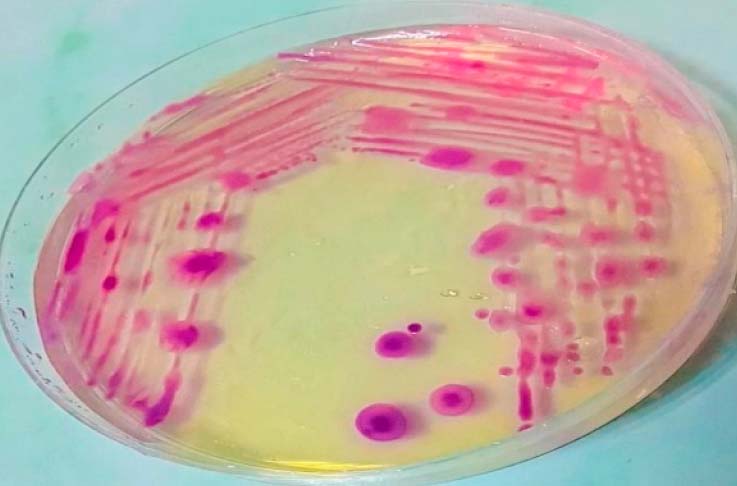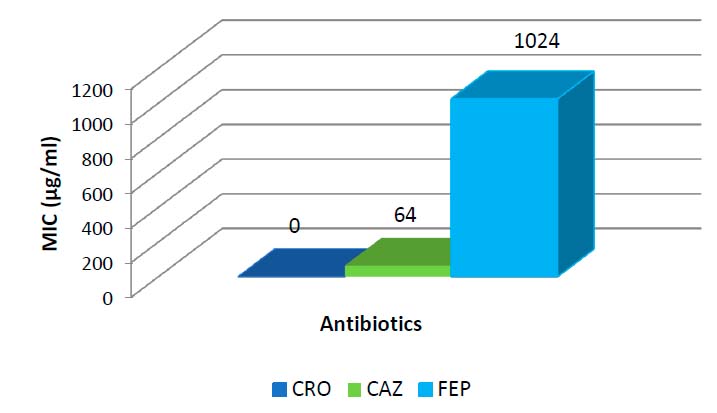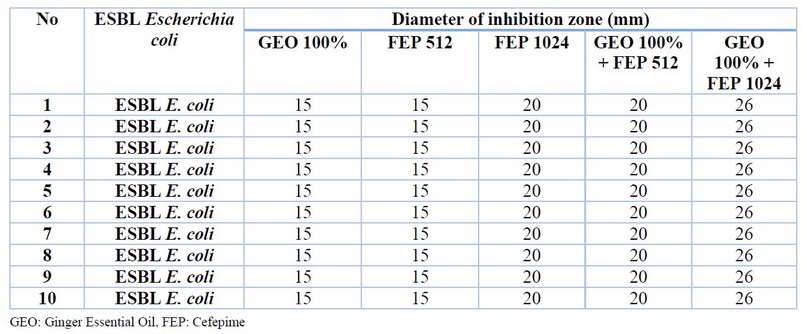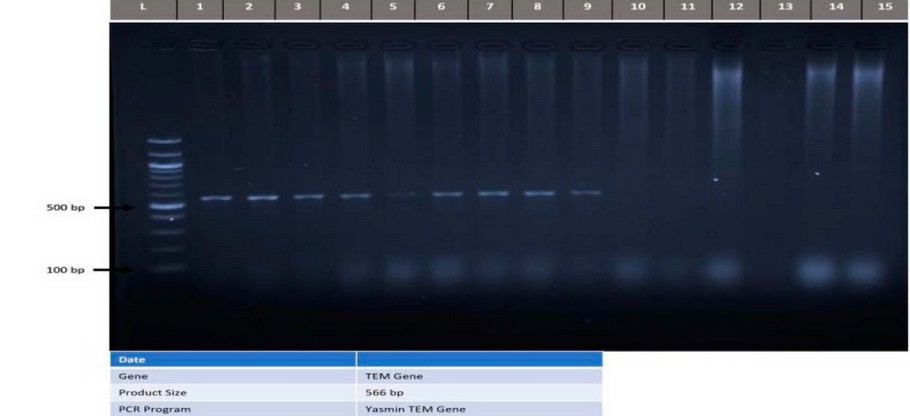2022.07.04.19
Files > Volume 7 > Vol 7 No 4 2022
Use of Ginger Essential Oil with Cephalosporin antibiotics as Beta-Lactamase inhibitors in pharmaceutical design to fight Escherichia coli UTI
Yasmin J. Khalil * and Shurook M.K. Saadedin.
Institute of Genetic Engineering and Biotechnology - University of Baghdad.
* Correspondence: e-mail: [email protected].
Available from: http://dx.doi.org/10.21931/RB/2022.07.04.19
ABSTRACT
This research aimed to investigate multi-target inhibitors against the Beta-Lactamases protein of urinary tract infections (UTI) Escherichia coli, which is considered the main virulence factor of this bacterium. Drug design is regarded as a new approach to drug discovery and industry. The combination of Ginger Essential Oil (GEO) and Cefepime (FEP) showed effective results against Beta-Lactamase enzymes of UTI E.coli, 512 FEP+ 100% GEO and 1024 FEP + 100% GEO for (20 mm and 26 mm) inhibition zone respectively. The present study concluded that the isolates of E.coli of UTI from Iraqi hospitals were MDR and XDR, and their virulence was due to the presence of blaTEM genes. In silico screening, servers have been used to design an inhibitor model for Beta-Lactamases from the natural product of GEO. Cefepime and Ginger's essential oil showed a strong synergistic effect on these bacteria.
Keywords: Escherichia coli; ESBLs; Ginger Essential Oil; Cefepime; UTI
INTRODUCTION
Escherichia coli-producing enzymes Extended Spectrum Beta-Lactamases (ESBLs) has appeared as a significant reason for UTI. ESBLs are the enzymes that hydrolyze all Penicillins, Cephalosporins and Monobactams and cause cross-resistance to co-trimoxazole, fluoroquinolones and amino acids glycosides, all of which are commonly favored in UTI management1.
Essential oils and their constituents have been used to treat many human diseases since ancient times. Today, EOs are an alternative source with their oral, topical and aromatherapy treatment. Essential oils are compounds from spices, aromatic herbs, fruits, and flowers. Extract of Ginger was confirmed effective against four test organisms – two drugs resistant and two non-drug-resistant bacteria. Thus, it is remarkable to recognize the potential use of Ginger Extract in treating infections caused by Staphylococcus aureus, E.coli, Methicillin Resistant Staphylococcus aureus, and ESBLEC2.
The prevalence of ESBL-producing E.coli urinary tract infections (UTIs) is increasing worldwide. The impact and risk factors were investigated3.
The study aimed to determine the bactericidal property of Ginger Essential Oil against Extended Spectrum Beta-Lactamase enzymes producing Escherichia coli (ESBLEC) in combination with Cephalosporin antibiotic.
MATERIALS AND METHODS
Patients Specimens Collection
Through the period extending from November /2021 to February /2022, 100 Clinical specimens comprising; patients suffering from (UTI) of all ages and genders. Urine samples were collected in sterilized containers from inpatients admitted in hospitals in Baghdad in Al-Karkh.
Laboratory Prepared Culture Media
All media, including MacConkey agar, Muller Hinton agar and broth, Nutrient agar and broth and Eosin Methylene Blue (EMB) agar, were prepared according to the manufacturing company instruction; the constituents were dissolved in distilled water (DW), pH was adjusted to 7.2± 0.2 then boiled in water to dissolve all branches completely. The sterilization of media was done by autoclaving at 121ºC for 15min at 15 pounds/inch2, then distributed into sterile Petri dishes; otherwise, the media were incubated at 37 ºC for 24 hours to ensure sterility.
Genes Selection
This study used conventional PCR to detect the following genes: Uniplex PCR was used to amplify ESBL, including blaTEM gene.

Table 1. Listed the Sequences of the Primers Used for Conventional PCR to Detect Beta-lactamase Gene.
Minimum inhibitory concentration (MIC) was determined by agar dilution and broth dilution method against antibiotic Ceftazidime (CAZ), Ceftriaxone (CRO), and Cefepime (FEP) of antibiotic powders. A loop entire (1μl) of culture was streaked on MH broth plates containing antibiotics at a concentration of (64, 128, 256, 512, and 1024 μg/ml); these plates were incubated for 24 hours at 37°C. Growing colonies were macroscopically observed after 24 hours 4,5.
Minimum Inhibitory Concentration (MIC) of Ginger Essential Oil (GEO)
Minimum Inhibitory Concentration (MIC) was determined by agar well diffusion method, loop full (1μl) growths from bacterial isolate that were inoculated into nutrient agar and then incubated at 37 °C for 24 hours. The bacterial suspensions were diluted with normal saline. Adjust the turbidity and compare with the standard tube (McFarland number 0.5) to yield a uniform suspension containing 1.5×108 CFU/ml. A cotton swab was dipped and streaked into adjustment suspension the entire Mueller-Hinton agar (for all tested bacteria) surface of plates. Media were cut into four wells (6mm diameter) by cork borer, diluting the oil with 10 % DMSO. 100 μL of GEO were added into wells (The plates were performed in triplicates) at 100%, 50%, 25%, and 12.5%. All plate of the tested organisms was then allowed to incubate at 37°C overnight. After 24 hours of incubation, each plate was noted for the zone of inhibition for all isolates. The inhibitions zone's diameter was measured by measuring scale in millimeters (mm)6.
Estimation of Antibacterial Effect
Depending on the MIC value of fourth antibiotic generation of cephalosporin (Cefepime). The optimum MIC value was selected according to the growth of bacteria; the concentration of inhibition was 1024 µg / ml of Cefepime, and the focus taken below was 512 µg / ml. The highest concentration of Ginger oil was taken 100 %. The same wells method was used for antibiotic FEP and GEO,7 Depending on who indicated that quercetin showed high antibacterial activities and additive or synergistic effects with the antibiotic.
Zingiber officinale (Ginger)
Zingiber officinale (Ginger) rhizomes were bought from the market of Baghdad city and classified in the College of Science, Department of Life Biology, the University of Baghdad as Zingiber officinale Roscoe.
Activation of Bacteria
Bacteria were activated in brain-heart infusion broth and then incubated at 37°C for 24 hrs.
Pre – Treatment
100 E.coli clinical isolates DNA were extracted after growing in brain-heart infusion broth (BHIB) (without antibiotic and GEO), then incubated at 37 ℃ to detect blaTEM..
Essential Oil Extraction
The essential oil was extracted from the Ginger plant rhizomes using a specialized Clevenger device to remove the light oil connected with a volumetric flask of 1000 ml, as 200 gm. Fresh Ginger rhizomes were mixed with 500 ml of (DW), then the distillation process was carried with 80-90 ℃, and distillation lasted 2 hours. As a result, the oil yield obtained for every run was calculated using (1)8.

RESULTS
Isolation and Identification of Escherichia coli
The isolates that were obtained from the 100 samples were identified according to the following characteristics observed.
Isolation and Identification of Escherichia coli
In CHROMagar, isolates of E.coli appeared as pink-red colonies at 37°C for 24 hours, as shown in Figure (1); this medium also has selectivity for other urinary tract pathogens with a specific color for each bacterial genus. Chromogenic agars are reliable for detecting aerobic Gram-negative bacteria by easier recognizing different colonies on these media.

Figure 1. Growth of Escherichia coli on CHROMagar after incubation at 37°C for 24 hours.
Minimum Inhibitory Concentration (MICs) Susceptibility Test
Minimum inhibitory concentration (MICs) is defined as the lowest concentration of an antimicrobial agent that will inhibit the visible growth of microorganisms after incubation. The antibiotic susceptibilities of clinical isolates of Multi-Drug Resistant E.coli (MDREC) were determined in terms of MICs of antibiotics against the isolates, using the agar dilution method. The MICs that have been investigated in the present study are shown in Figure (2).

Figure 2. Minimum Inhibitory Concentrations (μg/ml) of Antibiotics Against Escherichia coli Ceftriaxone (CRO), Ceftazidime (CAZ),
Cefepime (FEP), CRO: (64 µg/mL -1024 µg/mL) Resistance, CAZ: (64 µg/mL) Sensitive, FEP:(1024 µg/mL) Sensitive.
This indicated that the MIC value of Ceftazidime (CAZ) was at a concentration (64 µg/mL), and of Cefepime (FEP) was at a concentration (1024 µg/mL). Finally, E.coli isolates exhibit a high resistance to Ceftriaxone (CRO).
Minimum Inhibitory Consecration (MICs) OF Ginger Essential Oil (GEO).
Wells method was utilized after the 24 hours incubation period, for 40 samples (containing genes blaTEM) qualified as the final study sample (each sample was repeated three times). The GEO exhibited varying degrees of inhibitory activity against the ESBL E.coli. As expected, higher GEO concentration produced wider zones of inhibition. Table (2) Shown antibacterial activity of GEO against ESBL (UTI) E.coli.

Table 2. The Antibacterial activity of Ginger Essential Oil against Extended Spectrum Beta-Lactamase Escherichia coli
Estimation of Antibacterial Effect
Depending on the MIC value of the fourth antibiotic generation of cephalosporin (Cefepime) for ten isolates, the optimum of MIC value was 1024 µg/ml of Cefepime, and the concentration was taken below 512 µg/ml. The highest MIC of GEO was 100%. The same wells method was used, as shown in table (3).

Table 3. Estimation of Antibacterial Effect of Ginger Essential Oil and Cefepime antibiotics against Extended Spectrum Beta-Lactamase Escherichia coli
In the table (3), the optimal MIC value of the GEO that appeared in this study is 100% (15 mm), the optimum MIC value of the Cefepime 512 and 1024 (15 mm and 20 mm inhibition zone, respectively), while the mixed of GEO and FEP (100% + 512 and 100% + 1024) was (20 mm and 26 mm inhibition zone respectively). Compared with CLSI, the bacteria were resistant and became sensitive when treated with GEO and FEP.
Molecular Detection blaTEM gene
The prevalence of Beta-Lactamases producing genes (blaTEM) was detected and determined for each E.coli clinical isolate in the present study shown in Figure (3).

Figure 3. Gel Electrophoresis profile of blaTEM Gene PCR Product (566bp) on 2%Agarose gel with ethidium bromide (5V/cm, 80 mins).
In this study, the optimal annealing temperature of the reaction was 50 °C. However, the annealing temperature of the reaction started at 67 °C and decreased to about 1°C every second cycle until the optimum annealing temperature of primer was reached, followed by 15 additional cycles at 50 °C. The minimum number of processes needed during the earlier part of the TD program to eliminate nonspecific priming would depend on the amplification's efficiency during high-temperature cycling.
DISCUSSION
CHROMagar Orientation medium is preferred medium because of the high accuracy and the `rapid identification with meager false favorable rates 9,10. This media is regarded as highly selective and sensitive media for E.coli, and this media contains agents which inhibit the growth of most gram-positive organisms. It incorporates substrates enabling color-based preliminary identification of colonies recovered within 24 h of inoculation. 71 of the 100 sample isolates were suspected to be E.coli; these results were similar to11.
Clinical laboratories use MICs mainly to confirm resistance; they are also employed as a research tool for determining the activity of new antimicrobial agent and their MIC breakpoints12.
The result of the present study for Cefepime and cefotaxime MIC agreed with the result of 13, which showed higher catalytic efficiency observed of ceftazidime and Cefepime. Beta-lactam antibiotics are the most prescribed antimicrobial class. The efficacy of Beta-lactams is threatened by the production of Beta-lactamase enzymes, the predominant resistance mechanism impacting these agents in Gram-negative bacterial pathogens. The Beta-lactam antibiotic cefepime inhibits Broad-Spectrum Beta-Lactamase in E.coli14. Antibiotic resistance is a growing concern when treating bacterial infections. The number of resistance mechanisms acquired by bacteria is increasing each year and the prevalence of multidrug-resistant (MDR) bacteria is also increasing15. Few treatment options remain as the rate of discovery and development of new antibiotics is outpaced by bacterial resistance development16.
GEO substances act individually or in synergy with one another, including but not limited to sesquiterpene compounds like bisapolene, zingiberene, zingiberol, sesquiphellandrene, curcurmene, phenolic compounds like shogaols and gingerols, and other compounds like 6-dihydrogingerdione, galanolactone, gingesulfonic acid, zingerone, geraniol, neral, monoacyldigalactosylglycerols and gingerglycolipis 17-19. The extract may have caused irreparable damage to the gram-negative bacteria's outer membrane, causing their eventual death. Gram-negative bacteria have hydrophilic outer membranes owing to lipopolysaccharide molecules permitting only lipophilic compounds and macromolecules. If these molecules have antibacterial activity, they can penetrate the middle layer (which comprises a skinny peptidoglycan layer) and disturb cellular function, metabolism, and loss of cellular constituents, leading to bacterial death20,21; also reported a similar explanation in their studies.
Analyses show that GEO, combined with other antimicrobials, exhibits different effects (additive, synergistic, indifferent and antagonistic) against E.coli. The result above in agreement with7, who indicate that quercetin showed high antibacterial activity, additive or synergistic effect with antibiotic against E.coli.
The production of beta-lactamases, a family of enzymes that hydrolyze the beta-lactam ring, thereby inactivating the antibiotic molecule before binding with PBP's, is the principal mechanism of resistance to Beta-Lactam antibiotics. They also play a significant role in bacteria's intrinsic and acquired resistance, mainly in gram-negative 22. Comparing the inhibitory activity shows that the GEOs are more effective against ESBL E.coli when added to the antibiotic Cefepime (FEP). The extract may have caused irreparable damage to the gram-negative bacteria's outer membrane, causing their eventual death. Gram-negative bacteria have hydrophilic outer membranes owing to the presence of lipopolysaccharide molecules permitting only lipophilic compounds and macromolecules. If these molecules have antibacterial activity, they can penetrate the middle layer of gram-negative bacteria (which comprises a skinny peptidoglycan layer) and disturb cellular function, metabolism, and loss of cellular constituents, leading to bacterial death.20,21 reported a similar explanation in their studies. The absence of blaSHV and the presence of blaTEM were seen in 23, similar to the finding in the present study.
CONCLUSIONS
Escherichia coli identified by molecular technique gives more accurate bacterial identification than traditional methods. Most local clinical isolates of E.coli had multidrug resistance to most antibiotics used to treat these bacteria in our hospitals. According to molecular techniques, all of the present study's local clinical isolates of E.coli were blaTEM genotypes. Using the antibacterial test, Ginger Essential Oil gave a synergistic effect when added to the antibiotic, which led to breaking the resistance of E.coli.
REFERENCES
1. Kim, Y.; Yang, E. and Kim, J. Urinary tract infection caused by community-acquired extended-spectrum β-lactamase-producing bacteria in infants. J Pediatr, 2017; 93 (3):260-266.
2. Alfredo, V.; Mercita, Q.; Amante, P.; Cabatu, J. and Gabriel, P. Bactericidal Property of Zingiber officinale (Ginger) Extract Against Staphylococcus aureus, Methicillin Resistant Staphylococcus aureus (MRSA), Escherichia coli and Extended Spectrum Beta Lactamase Escherichia coli,2021; 25 (4): 20548 – 20561.
3. Vachvanichsanong, P.; McNeil, EB. and Dissaneewate, P. Extended-Spectrum Beta-Lactamase Escherichia coli and Klebsiella pneumoniae urinary tract infections. Epidemiology and Infection, 2021;149 (12):1–7.
4. Bhattacharjee, A.; Sen, M.; Prakash, P.; Gaur, A. and Anupurba, S. Increased prevalence of Extended Spectrum Βeta-Lactamase producers in neonatal septicaemic cases at a tertiary referral hospital. Indian Journal of Medical Microbiology,2008; 26 (4): 356-360.
5. Uemura, S.; Yokota, S.I.; Shiraishi, T.; Kitagawa, M.; Hirayama, S. and et al. Adaptive Cross-Resistance to Aminoglycoside Antibiotics in Pseudomonas aeruginosa Induced by Topical Dosage of Neomycin. Chemotherapy, 2017; 62 (2): 121-127.
6. Kadhim, N.K.; Ahmad, Z.K. and Ghani, Z.A. Ntibacterial Activity of The Aquatic Extractof Fresh, Dry Powder Ginger, Apple Vinegar Extract of Fresh Ginger and Crude Oil of Ginger (Zingiberofficinale) Against Different Types of Bacteria in Hilla City, Iraq. Int J Pharm Pharm Sci, 2014; 6(5):414-417.
7. Wu, Y.; Chai, B.; Wang, L.; Jiang, W.; Hu, M. and et al. Antibacterial activity of total flavonoids from Ilex rotunda Thunb. and different antibacterials on different multidrug- resistant bacteria alone or in combination. bioRxiv,2018; 457911.
8. Khalil, Y.J. and Saadedin, S.M.K. Chemical Components GC-MS Analysis of Ginger Essential Oil and Antimicrobial Activity against Escherichia coli ,2022; In press.
9. Filius, P.; Van Netten, D.; Roovers, P.; Vulto, A.; Gyssens, I.; Verbrugh, H. and et al. Comparative Evaluation of three chromogenic agars for detection and rapid identification of aerobic Gram-negative bacteria in the normal intestinal microflora. Clinical Microbiology and Infection,2003; 9 (9):912-8.
10. Claire, J.; Neil, T.; Perry, G. and Saheer, G. Evaluation of chromogenic selective agar (CHROMagar STEC) for the direct detection of Shiga toxin-producing Escherichia coli from faecal specimens. Journal of Medical Microbiology,2020; 69 (3):487.
11. Naser, A.; Mohammad, A.R.; Hossein, S. K.; Mohammad, H.; Mohammad, Y.; Morteza, M. and Reza, G. Detection of carbapenem-resistant Enterobacteriaceae by chromogenic screening media. Journal of microbiological methods,2018; 153, 40-44.
12. Vijayakumar, R.; Aboody, M.; AlFonaisan, M.; Turaiki, W.; Mickymaray, S. and et al.Determination of Minimum inhibitory concentrations of Common Biocides to Multidrug-Resistant Gram-negative bacteria. Applied Medical Research,2016; 2(3): 56.
13. Othman Ghazi Najeeb Alani , Yassen Taha Abdul-Rahaman and Thafer Thabit Mohammed. Effect Of Vêo® Premium and Vitamin C Supplementation on Lipid Profile Before and During Pregnancy in Some Local Iraqi Ewes During Heat Stress. Iraqi Journal of Science.2021, Vol. 62, No. 7, pp: 2122-2130.
14. Elyse, J.; Tsuyoshi, U.; Denis, M.; David, A. and Cezar, M. The Next-Generation b Lactamase Inhibitor Taniborbactam Restores the Morphological Effects of Cefepime in KPC- Producing Escherichia coli,2021; 9 (2): e00918-21.
15. CDC. Antibiotic resistance threats in the United States. US Depart- ment of Health and Human Services, CDC, Atlanta, GA,2019; p:150.
16. Jean, S.; Gould, I.M.; Lee, W.S. and Hsueh, P.R. International Society of Antimicrobial Chemotherapy (ISAC). New drugs for multidrug-resistant Gram- negative time for stewardship. Drugs, 2019; 79:705-714.
17. Singh, A. P. and Malhotra, S. Medicinal Properties of Ginger (Zingiber Officinale Rocsc). Indian Journal of Natural Products and Resources, 2003; 2 (6):296-301.
18. O'Hara, M.; Keifer, D.; Farrel, K. and Kemper, K. A Review of 12 Commonly Used Medicinal Herbs. Archives of Family Medicine, 1998; 7(6): 523
19. Yassen, D. and Ibrahim, A.S. Antibacterial Activity of Crude Extracts of Ginger (Zingiber officinale Rosque) on Escherichia coli and Staphylococcus aureus: A study in vitro. Indo American Journal of Pharmaceutical Research, 2016; (6):5830-5835.
20. Rajeshwar, Y.; Gupta, M. and Mazumder, U. In Vitro Lipid Peroxidation and Antimicrobial Activity of Mucana pruriens Seeds. Iranian Journal of Pharmacology, 2005; 4(1):32-35.
21. Kuete, V.; Nguemeving, J.R.; Beng, V.P.; Azebaze, A.G.; Etoa, F.X.; and et al. Antimicrobial Activity of the Methanolic Extracts and Compounds from Vismia laurentii De wild (Guttiferae). Journal of Pharmacology, 2007; 109 (3):372-9.
22. Dias, C.; Borges, A.; Oliveira, D.; Martinez-Murcia, A.; Saavedra, M. J. and Simoes, M. Biofilms and antibiotic susceptibility of multidrug-resistant bacteria from wild animals. Peer. J., 2018; 6: e4974.
23. Mirkalantari, S., Masjedian, F., Irajian, G., Siddig, E. E., and Fattahi, A. Determination of the frequency of β-lactamase genes (bla SHV, bla TEM, bla CTX-M) and phylogenetic groups amomarng ESBL-producing uropathogenic Escherichia coli isolated from outpatients. Journal of Laboratory Medicine, 2020; 44 (1):27–33.
Received: July 20 2022 / Accepted: October 15 2022 / Published:15 November 2022
Citation: Khalil, YJ.; Saadedin, SMK. Pharmaceutical Design Using a Combination of Cephalosporin Antibiotic and Ginger Essential Oil as Beta-Lactamase Inhibitors Against UTI Escherichia coli.Revis Bionatura 2022;7(4) 19. http://dx.doi.org/10.21931/RB/2022.07.04.19
